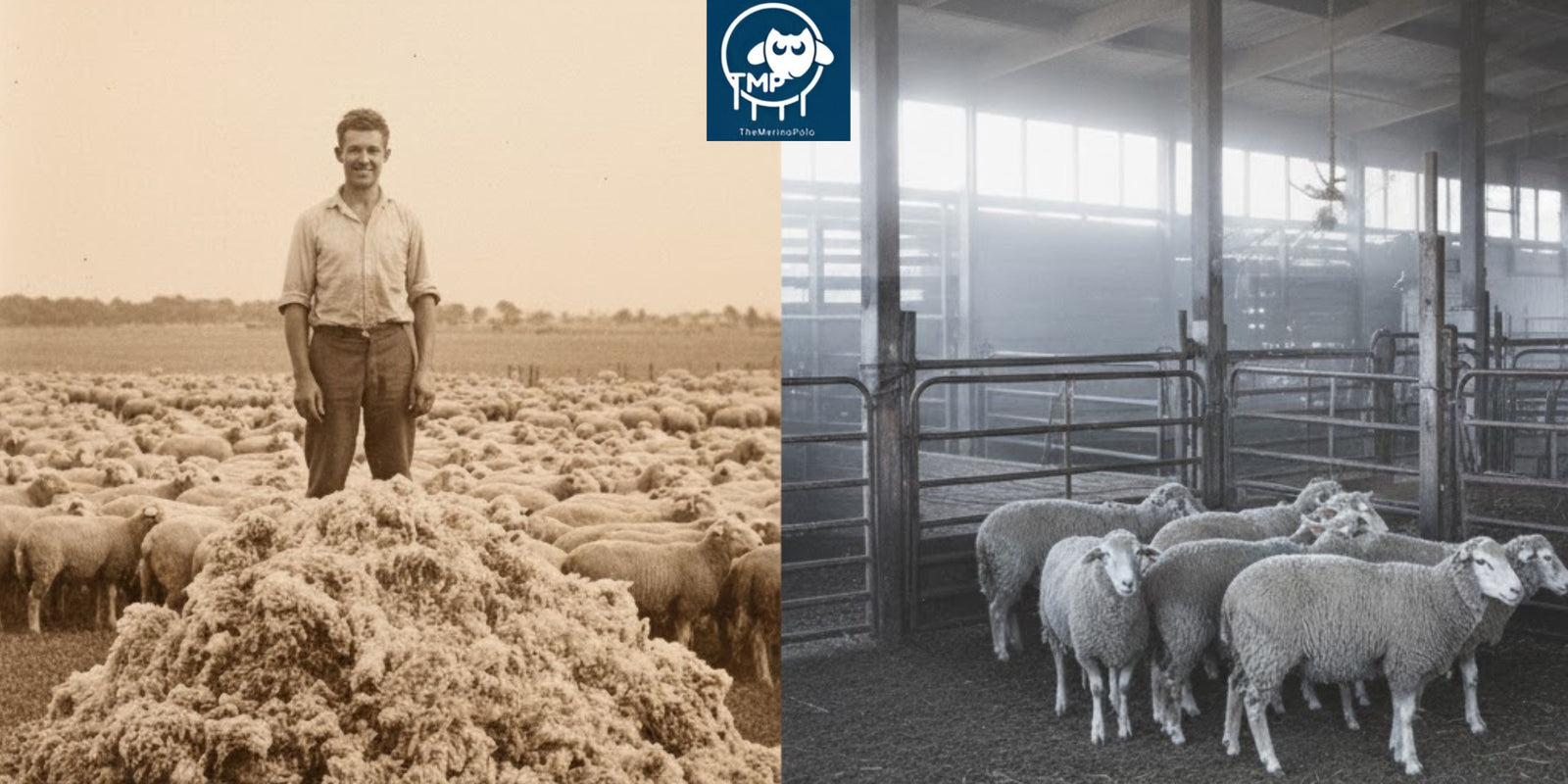The Decline of the Australian Merino Industry Since 1990 — and Why It’s Time for a Revival?

Australia was once known as the country that rode on the sheep’s back. From the dusty paddocks of New South Wales to the highlands of Tasmania, Merino sheep defined our national story. But since 1990, something’s changed. The proud hum of shearing sheds has faded, and the once-mighty Merino industry has quietly shrunk to a fraction of its former strength.
Unfortunately, this is the time our founder, Steve Noa, started his journey in the Australian Wool Industry. A broker, then a buyer. A trader and exporter and now the founder of The Merino Polo.
Today, the Australian wool industry produces far less than it did in its golden age — and yet, the quality of our Merino fibre remains unmatched. So, what caused the decline? And more importantly, what will bring it back?
The Golden Age of Merino: When Wool Ruled the World
In the late 1980s, Australia’s wool industry was at its peak. Supported by the Reserve Price Scheme, farmers were guaranteed a minimum price per kilogram of wool. This system encouraged huge flocks and heavy production — at one point, Australia ran over 170 million sheep, and exported more than 4.5 million bales of wool each year.
Merino wool was the pride of the land — soft, strong, and entirely natural. Our exports clothed the world, from Italian luxury suits to military uniforms. The fibre was seen as a symbol of purity, performance, and prosperity.
But in the early 1990s, that confidence came crashing down.
The Crash of 1991: When the Bottom Fell Out
In 1991, the Reserve Price Scheme collapsed under an avalanche of its own success. Farmers had produced more wool than the world could absorb. The government stockpile ballooned to over 4.7 million bales, and when price supports were withdrawn, wool values fell off a cliff.
Within months, farmers faced a market where their wool was worth less than it cost to shear and sell. Thousands of sheep were destocked or turned over to meat production. Many families left the industry altogether. The phrase “wool mountain” became a painful reminder of lost value and broken trust.
Then came the second blow — synthetic fibres.
The Rise of Synthetics and the Fall of Natural Fibre
By the 1990s, synthetic fabrics like polyester and nylon had captured the imagination of global fashion. They were marketed as “modern,” “lightweight,” and “easy care.” Shoppers were told these man-made materials could do everything wool could — only cheaper.
The truth, of course, was different. Synthetics trapped odour, shed microplastics, and couldn’t match wool’s breathability or biodegradability. But consumers were swayed by price and convenience, and the shift hit Australian wool hard.
As fashion moved toward fast and disposable, Merino — the ultimate slow, sustainable fibre — was left behind.
Changing the Landscape: From Wool to Crops and Cattle
The market crash didn’t just shrink profits — it changed the entire landscape of Australian farming. Many producers turned to cropping, beef, or dairy, where returns were more predictable. Others diversified into mixed enterprises, or left the land entirely.
Shearing teams, wool classers, and rural towns that once revolved around the annual wool clip felt the impact. Australia’s national flock fell from 170 million in 1990 to around 70 million today — the lowest levels in nearly a century.
And with fewer sheep came fewer stories about wool. For many urban Australians, Merino became something their grandparents wore — an old-fashioned fibre that didn’t fit into a “modern” wardrobe.
The Global Shift: From Europe to China
Before the 1990s crash, most Australian wool was exported to Europe, especially Italy, where mills in Biella and Prato turned it into luxury textiles. After the collapse, however, China emerged as the dominant buyer. Chinese processors began buying up massive volumes of Australian wool, spinning and weaving it at lower cost.
Today, around 80% of Australia’s wool is processed in China before being exported to Europe or re-imported as finished garments. This shift kept demand alive — but it also meant that much of the “Australian Made” identity disappeared from the value chain.
We became the world’s best raw supplier, but not the world’s best storyteller.
The Cultural Drift: Losing the Wool Narrative
The decline wasn’t just economic — it was cultural. As generations moved away from the land, fewer Australians had a personal connection to wool. City consumers forgot how good Merino felt on the skin.
The fibre became stereotyped as itchy or old-fashioned. Meanwhile, synthetic “performance fabrics” flooded activewear and fashion markets, claiming wicking and odour-free properties that wool had offered naturally for centuries.
We stopped talking about what made Merino special — and the world forgot.
The Turning Point: Sustainability and the Modern Merino Revival
Thankfully, the tide is turning. In a world choking on fast fashion and plastic fibres, Merino wool has found new relevance. Consumers now crave natural, renewable, and biodegradable materials.
Modern processing has made Merino even softer and easier to care for — think machine-washable, wrinkle-resistant, and odour-free for days. It’s a natural fibre that genuinely performs.
And this is our motivation for our brand, The Merino Polo — showing that Merino isn’t just for the bush, but for the boardroom, the golf course, and the hiking trail. With its fine 18.5-micron fibres and modern design, today’s Merino polo shirts and T-shirts prove that performance and sustainability can coexist.
The global Merino revival isn’t about nostalgia. It’s about rediscovery — reminding people that we already have the world’s best fibre growing on Australian soil.
Rebuilding the Legacy: What Comes Next
Australia’s Merino industry may never return to the massive scale of the 1980s — and perhaps that’s a good thing. The future isn’t about producing more wool; it’s about producing better wool.
By investing in sustainability, traceability, and premium apparel, Australian growers and brands can create greater value per fleece. The story of Merino is still one of authenticity, craftsmanship, and endurance — qualities modern consumers are hungry for.
At The Merino Polo, we’re proud to play a small part in that revival — proving that the best performance wear on earth doesn’t come from a laboratory, but from the Australian paddock.
Conclusion: Listening to the Land Again
Merino wool didn’t fail Australia — we simply forgot to tell its story.
Now, as sustainability reshapes global fashion, the world is listening again. The softness, resilience, and integrity of Australian Merino are timeless. The industry may have declined since 1990, but its future is far from over.
It’s time to make Merino great again — one polo at a time.

